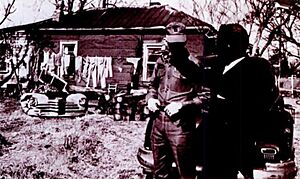Dobbins Heights, North Carolina facts for kids
Quick facts for kids
Dobbins Heights, North Carolina
|
|
|---|---|
| Country | United States |
| State | North Carolina |
| County | Richmond |
| Area | |
| • Total | 0.88 sq mi (2.29 km2) |
| • Land | 0.88 sq mi (2.29 km2) |
| • Water | 0.00 sq mi (0.00 km2) |
| Elevation | 397 ft (121 m) |
| Population
(2020)
|
|
| • Total | 687 |
| • Density | 778.03/sq mi (300.48/km2) |
| Time zone | UTC-5 (Eastern (EST)) |
| • Summer (DST) | UTC-4 (EDT) |
| ZIP code |
28345
|
| Area codes | 910, 472 |
| FIPS code | 37-17325 |
| GNIS feature ID | 2406381 |
Dobbins Heights is a small town located in Richmond County, North Carolina, in the United States. In 2010, about 866 people lived there. By 2020, the population was 687.
Contents
Where is Dobbins Heights?
Dobbins Heights is a town that covers about 0.9 square miles (2.29 square kilometers). All of this area is land. The United States Census Bureau provides this information.
The Story of Dobbins Heights
Dobbins Heights was once known as North Yard. It started as a community mainly for Black residents. It was not officially part of a city or town. This meant it received fewer government services.
In the 1960s, many homes in North Yard were rented. They often had poor conditions, like outdoor plumbing. Many streets were not paved even into the 1980s. People living there paid taxes to Richmond County.
Becoming a Community
Local churches were important gathering places. In the mid-1960s, a minister started the North Yard Improvement Association. This group helped raise money for streetlights.
In 1971 and 1972, Army engineers helped build a recreation area. In 1974, the community created its own volunteer fire department. This was because nearby fire departments did not provide enough help.
Becoming an Official Town
In 1976, residents asked the nearby city of Hamlet to include North Yard. Hamlet said no, partly because the area was not wealthy. Some people thought racism played a role in this decision.
After this, people in North Yard decided to become their own town. They started calling the community Dobbins Heights. This name honored Jim Dobbins, a minister who owned much of the land in the 1930s.
In 1983, a state representative helped. He introduced a bill to let people vote on becoming a town. On May 8, 1984, the vote happened. Most people voted yes, and Dobbins Heights officially became a town.
After becoming a town, a Black mayor and an all-Black city council were elected. These leaders worked to get money from the state and federal governments. They used this money to improve streets, parks, and the fire department.
Who Lives in Dobbins Heights?
| Historical population | |||
|---|---|---|---|
| Census | Pop. | %± | |
| 1990 | 1,144 | — | |
| 2000 | 936 | −18.2% | |
| 2010 | 866 | −7.5% | |
| 2020 | 687 | −20.7% | |
| U.S. Decennial Census | |||
The population of Dobbins Heights has changed over the years. In 1990, there were 1,144 people. By 2020, the population was 687.
People in Dobbins Heights (2020)
In 2020, there were 687 people living in Dobbins Heights. These people lived in 404 households. About 218 of these were families.
Here is a look at the different groups of people living in Dobbins Heights in 2020:
- Most residents, about 79.33%, were Black or African American.
- About 10.63% of residents were White.
- About 6.55% were from other racial backgrounds or mixed races.
- A small number were Native American (0.87%) or Asian (0.15%).
- About 2.47% of residents were Hispanic or Latino.
See also
 In Spanish: Dobbins Heights para niños
In Spanish: Dobbins Heights para niños



